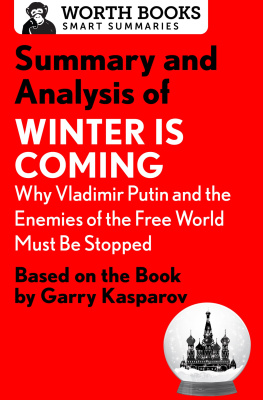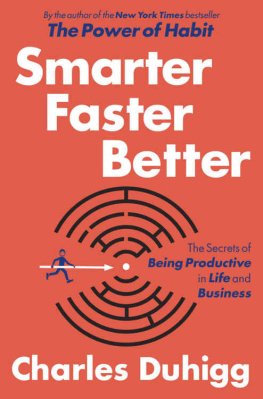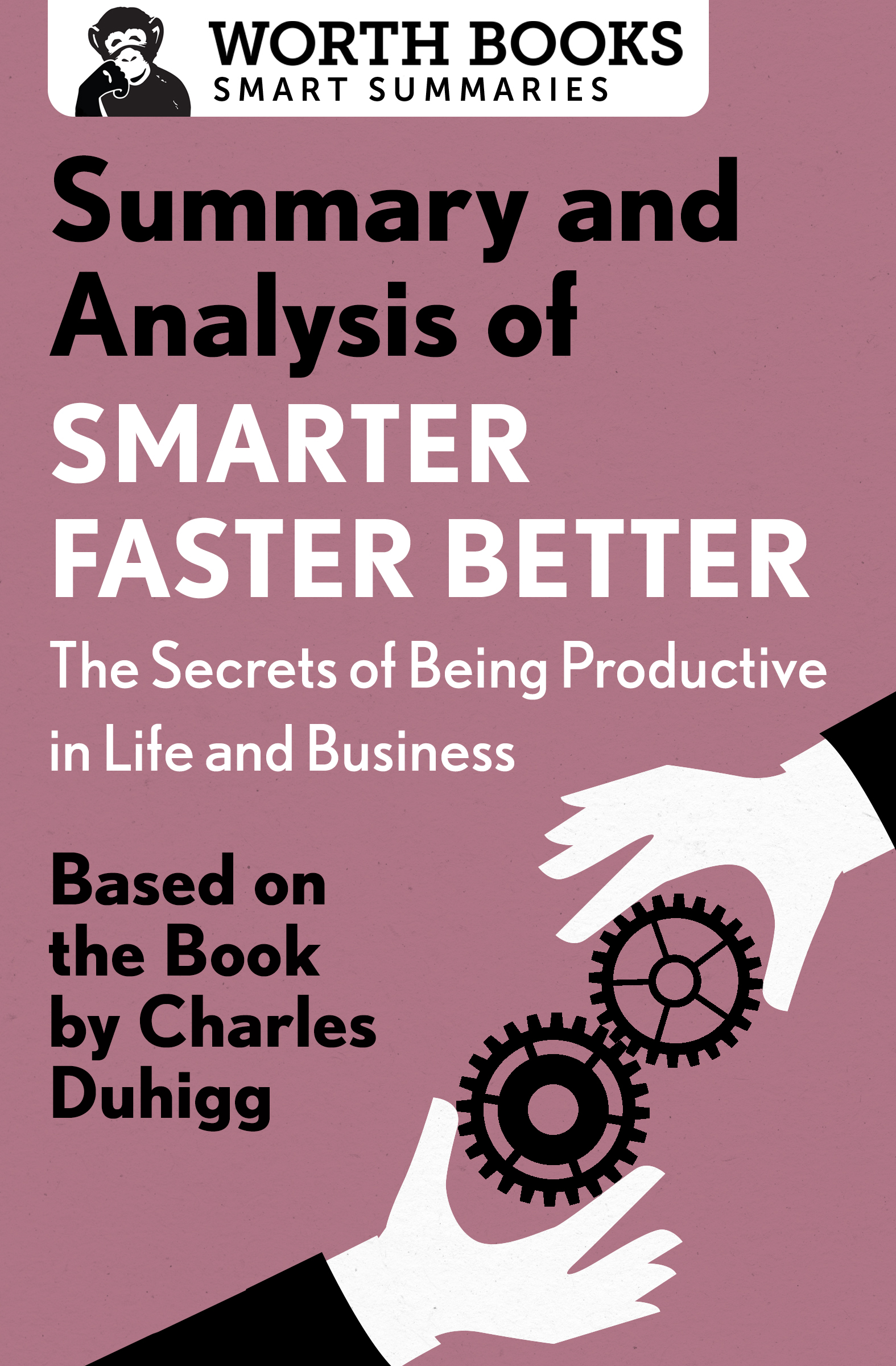Summary and Analysis of
Smarter Faster Better
The Secrets of Being Productive in Life and Business
Based on the Book by Charles Duhigg

Contents
Context
Smarter Faster Better is the follow-up to Charles Duhiggs 2012 bestseller, The Power of Habit. Like his first book, which focused on why habits form and how they can be changed, Smarter Faster Better weaves recent research in the fields of psychology, neuroscience, and behavioral economics with compelling narratives drawn from a wide range of professional fields to help readers improve their lives. Smarter Faster Better focuses on increasing productivity, which Duhigg defines as the process of learning how to succeed with less stress and struggle.
The Power of Habit and Smarter Faster Better are part of a recent and very popular trend of books based on behavioral science, which is the study of how humans and animals behave. Israeli psychologist Daniel Kahneman helped popularize the field in 2002, when he won the Nobel Prize in Economics for his work exploring how humans make decisions in the face of uncertainty. His book on this subject, Thinking, Fast and Slow (2011), was an international bestseller, and his collaboration with colleague Amos Tversky is the subject of a new book by Michael Lewis, The Undoing Project (2016). Other bestselling and influential behavioral science titles include Blink (2005) and Outliers (2008) by Malcolm Gladwell, Stumbling on Happiness by Daniel Gilbert (2006), Predictably Irrational by Dan Ariely (2008), Nudge by Richard H. Thaler (2008), and Quiet by Susan Cain (2012).
Unlike many of the authors in this field, Charles Duhigg writes about behavioral science from a laymans perspective. He is not a psychologist, a neuroscientist, or an economist, but rather a Pulitzer Prizewinning business reporter and columnist for the New York Times . His engaging prose style and deep connections to the worlds of business and entertainment allow Duhigg to synthesize complex scientific concepts in a clear and concise manner, and to illustrate his points with entertaining and memorable stories. Like many readers of Smarter Faster Better , Duhigg is a busy professional juggling the demands of work and family. In an essay for the New York Time s Well blog, he states that one motivation for exploring the secrets of productivity was to find the time in his busy schedule to eat dinner regularly with his wife and two young sons. He found the answer in the Toyota Production System, a management philosophy developed by the car manufacturer that seeks to locate the simple causes for complex problems by asking the Five Whys.
After interviewing friends, coworkers, professionals, and scientists to understand why some people are more productive than others, Duhigg published Smarter Faster Better in March 2016.
Overview
Smarter Faster Better tells the stories of some of the worlds most productive individuals and organizations, from a championship poker player to the creators of the blockbuster Disney film Frozen, in order to reveal the secrets of efficiency in work and in life. In his research, Duhigg identified eight key areas of focus that are essential to improving productivity:
- Motivation: A sense of control is crucial to self-motivation. Making choices, even small ones, increases our sense of control, and the closer we can link our choices to larger values and goals, the more motivated well be.
- Teams: To be successful, a group needs its individual members to believe that they have an equal voice and that they can share their honest thoughts and opinions without fear of reprisal.
- Focus: When we tell ourselves detailed stories about how we expect a situation to unfold, we improve our ability to distinguish between important and irrelevant information and react accordingly.
- Goal Setting: Huge leaps in productivity and innovation can occur when we break big, audacious goals down into the small steps necessary to achieve them.
- Managing Others: Companies can foster productivity by giving all levels of employees the power to make decisions about the issues with which theyre most familiar.
- Decision Making: Training ourselves to think about the future as a series of potential outcomes, each of which has certain odds of coming true, leads to better decisions.
- Innovation: There is no secret formula for creativity; however, we can take deliberate steps to improve the creative process by establishing conditions known to help innovation to thrive. These steps include bringing proven ideas into new settings and embracing creative anxiety as a source of inspiration.
- Absorbing Data: To avoid information overload, we should force ourselves to do something with new data. This can be as simple as explaining what weve just learned to a friend, or handwriting lecture notes instead of typing them into a computer.
Summary
Introduction
Charles Duhiggs interest in the science of productivity began as he was finishing his previous book, The Power of Habit . Overwhelmed with work and personal responsibilities, Duhigg sought the advice of Atul Gawande, a surgeon, New Yorker staff writer, bestselling author, Harvard professor, and adviser to the World Health Organization. Duhigg wanted to know how Gawande managed to accomplish so much. When he learned that the preternaturally busy doctor still found time to attend rock concerts with his kids and go on mini-vacations with his wife, Duhigg became convinced that some people know how to be more productive than others. He set out to discover their secrets, and soon noticed that the airline pilots, military generals, cognitive scientists, and others he interviewed were mentioning a handful of key concepts over and over. The eight most important ideas for improving productivity make up the eight chapters of Smarter Faster Better.
1. Motivation
Reimagining Book Camp, Nursing Home Rebellions, and the Locus of Control
In the late 1980s, French neurologist Michel Habib began studying cases in which people suddenly lost interest and energy for no apparent reason. In one such case, a middle-aged man was stung by a wasp and lost all desire to interact with his family and business colleagues. The neurologist discovered that the apathetic individuals had burst blood vessels inside their striatum. This part of the brain relays commands from the prefrontal cortex, where decisions are made, to the basal ganglia, where movement and emotions materialize. This is where ones motivation lives.
Further research has revealed that the anticipation of making a choice leads to increased activity in the striatum. However, when a choice is made on a persons behalf, his or her striatum remains essentially silent. The neurological relationship between motivation and choice indicates that people are more motivated when they believe they are in control.
Psychologists differentiate between an internal and an external locus of control. People with a strong internal locus believe they control their own destiny, while those with an external locus believe their lives are influenced by forces outside of their control. In an experiment that reveals the motivational power of activating an internal locus of control, a group of students were given a set of hard puzzles to solve. Each student was told they did a very good job. However, half of the students were complimented for working hard, while the other half was complimented for being smart. When a second set of puzzles was given out, the students who believed hard work was key to their success worked longer, did better, and had more fun with the new puzzles than the students who believed intelligencean innate capacity largely beyond their controlwas more important.










